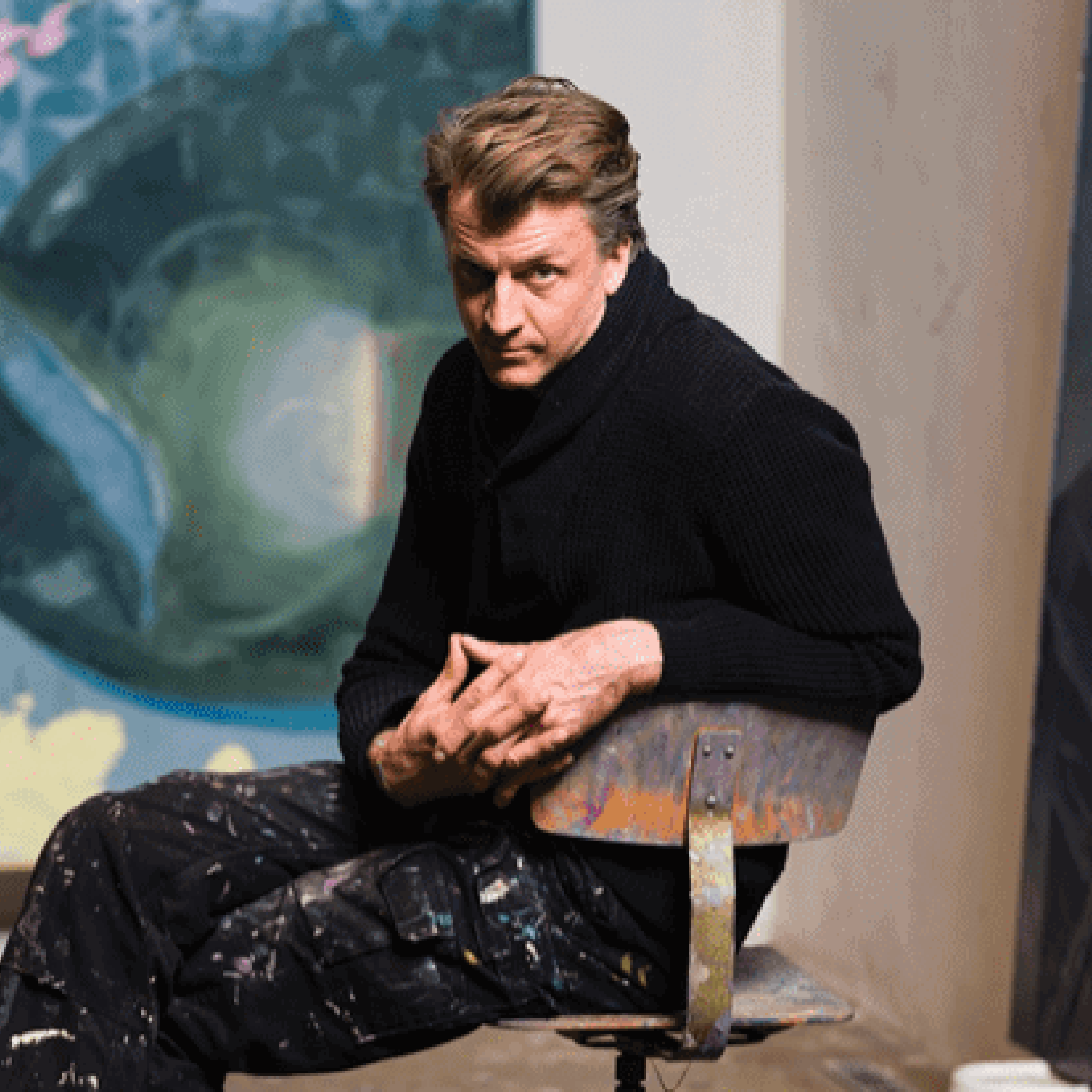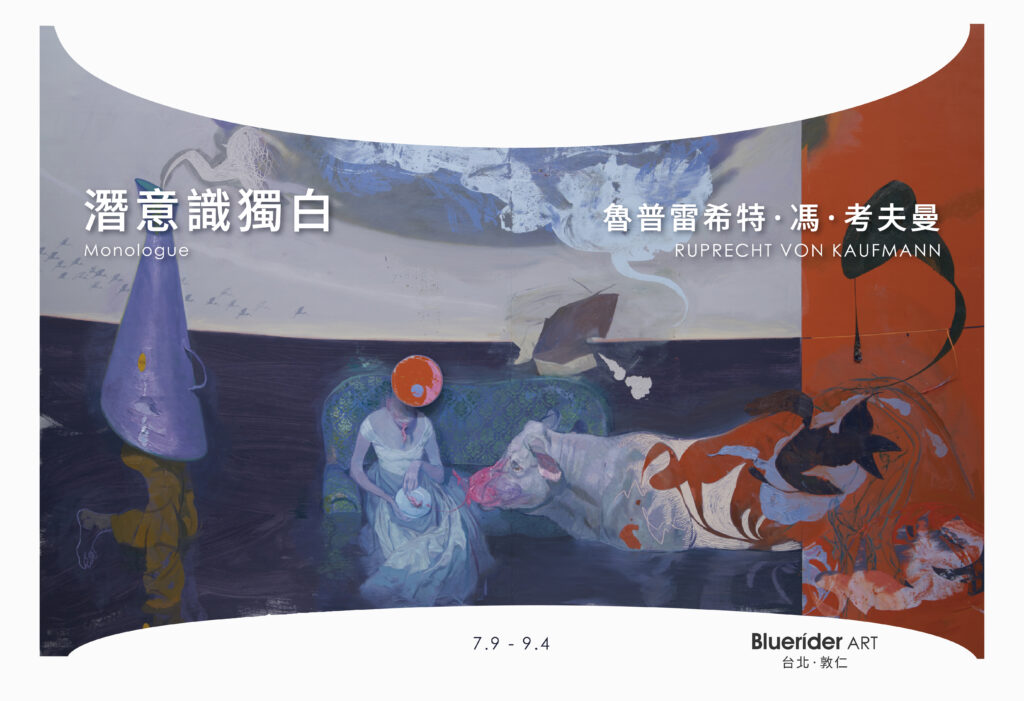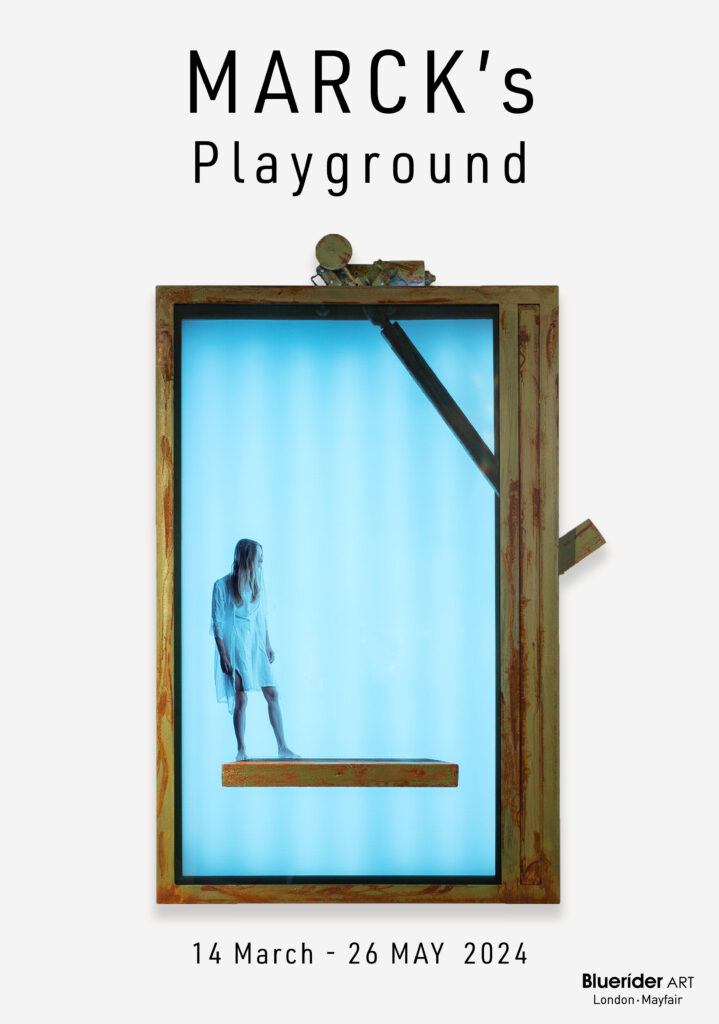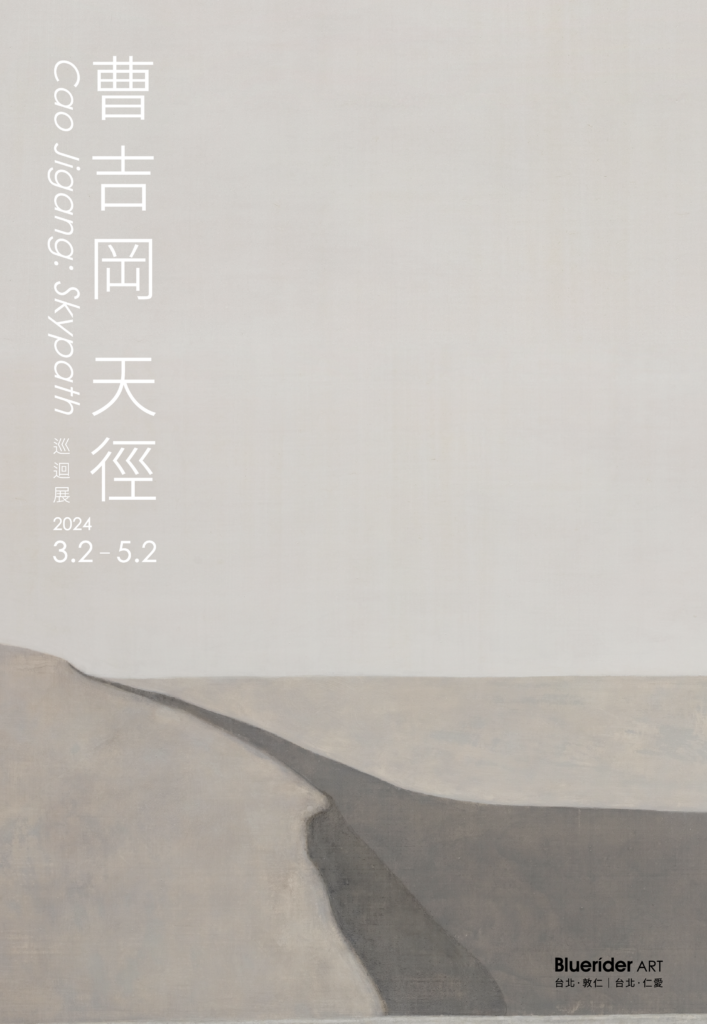作者:Sylvia Dominique Volz
为德国著名艺术顾问、编辑和策展人,于海德堡大学取得艺术史博士学位。她为私人藏家及企业机构提供当代艺术收藏顾问谘询,同时也多次担任知名当代艺术私人收藏指南《BMW艺术指南》(The BMW Art Guide)主编。
图像形成如一面(扭曲的)现实之镜
IMAGE FORMATION AS A (DISTORTING) MIRROR OF REALITY
By Dr. Sylvia Dominique Volz
人类存在的所有复杂性—那种透过操纵来控制他人的努力,一种无关乎理性或非理性的原始本能行为—是Ruprecht von Kaufmann作品的主轴。在这里,人类因为其世俗存在中的需求、脆弱、与有限性,被大自然与自身物种视为是一种威胁。
既深沉又神秘地,这些画作吸引着观众并使他们着迷。我们受到作品的加密与相互矛盾性质所带来的多样性与复杂性挑战。它们释放了我们内心的各种联想,从而产生了一种混合的情绪;正如同艺术家所指出的,这些情绪与我们自己的生活经验最密切相关:从焦虑不安、沮丧、与感觉到受威胁,到喜悦、爱、与希望—而且有时候混合这所有情绪于一张画作之中。我们试图参与、破译、和理解事物,最终得出结论发现这所发生的一切不全是在眼前,更多的是发生在我们自身上面。这些画作主角是反映出我们自己吗?我们扮演着什么角色?我们是否参与于展开的画作前并将其意念延伸成为自我的一部份呢?
因此,这些成为与身为观者的我们产生共鸣与互动的图像。在社交媒体的世代,这对我们来说似乎很自然。Ruprecht von Kaufmann本人着迷地观察着所谓的用户如何利用叙述来塑造他们自己的个人特质。这些即是被操控的主观真相,因为有些图像的设计确实旨在向外传达意念。观看的时候,脑中所感知到的是情感上触动观者的一幅美丽(被美化的)肖像,因为它产生了一种匮乏感且唤醒了深沉的隐性需求。简而言之,Ruprecht von Kaufmann艺术地捕捉了现实与虚构之间的差异。在他一幅描绘一位背对着的女性正在脱去她比例匀称的皮肤的画作中,显现出来的是一位瘦到近乎消失的纤弱人形,而且她与即将要被抛掉的皮肤形象几乎没有任何共同之处(Take off Your Skin[译:脱去你的外皮]。(Take off Your Skin[譯:脫去你的外皮])。
然而,人们套用各种角色或扮演操控形象这种行为,不仅是现代现象,而是或多或少地贯穿了整个人类与艺术史;人类始终在乎着他们想成为什么样的人以及他们想要被看到的角色。即便是在古代,人或表面形象的概念也普遍地被演员应用于所使用的面具以及其于生活中或戏剧中所扮演的角色。几个世纪以来,肖像,不论是文字还是图像,从轮廓到每个小细节都经常被精心设计着:想想那些以精心部署的象征手法来炫耀自己社会地位、教育程度、以及所谓高尚特质的统治者们,从而以最真实的意义建构了他们的形象。
Ruprecht von Kaufmann对于在真实与虚构世界之间摇摆不定的形象特别感兴趣;因此,对于美国创作歌手 Tom Waits所写的歌词成为他的灵感来源之一也就不足以为奇了—这位音乐家本身就是一位难以自我受限的创作家,他以在歌词中呈现各种虚构人物并营造出一种不一致且复杂的氛围为特色,如同我们在Ruprecht von Kaufmann的作品中所感受到的那般。画作中的主角以不同的形式出现,有些带有强烈的操控或威吓感,有些则是有需求或脆弱的感觉。我们会遇上一些奇特的混合型生物,例如半人马这种怪物睡在床上,然后一位裸体的女性信任地依偎在它身上(Monster [译:怪物]),或者是一个完全被包裹在像麻布袋中的生物蹒跚地在房间内移动着(Die Gefährten [译:伙伴们])。他们的真正身份其实并未向我们揭露,尤其因为他们的头被转向、被扭曲得面目全非、或者被遗漏了。由于我们总是试图阅读与识别脸部特色以定位我们与对方之间的关系,这样的呈现更是让人感到困惑。(Monster [譯:怪物]),或者是一個完全被包裏在像麻布袋中的生物蹣跚地在房間內移動著(Die Gefährten [譯:夥伴們])。他們的真正身份其實並未向我們揭露,尤其因為他們的頭被轉向、被扭曲得面目全非、或者被遺漏了。由於我們總是試圖閱讀與識別臉部特色以定位我們與對方之間的關係,這樣的呈現更是讓人感到困惑。
基于明显受到人们与其行为控制的因素,当观察那些有时显得复杂的图像空间时,我们容易疏忽地断言Ruprecht von Kaufmann的作品缺乏叙述性。事实上,这并非艺术家本意:在他看来,叙事是触动人们情感的基本手法。因此,他不愿意单纯地从形式或知识层面上接触绘画。这确实值得注意,因为这使他的画作与当前艺术语境对绘画叙事的消极态度相悖。此外,这种立场十分有趣,因为Ruprecht von Kaufmann让人对他的印象是拥有高智商的人,而且他的画作更是证明他对历史、文学、古代神话与音乐有着深入的研究。
尽管如此,在观众眼前展开的一切无论如何都不能被视为一个完全发展的故事。相反的是,它们是片段,或者更确切地说,它们是带有暗示意味但不是解答的叙述线索。一开始,艺术家使用符合我们既定观看模式与主观经验视野的有形手法来唤起叙事,因而提供了一种看似简单的方式进入图像。这种手法同样适用于马戏团场景、山景、或例如童年或成年过渡时期的自传主题等应用。
随后,我们便会对自我假定的见解产生怀疑。Ruprecht von Kaufmann便向我们展示各种难以理解的细节,像是一匹有两个后驱的马(Pastorale [译:牧人]),一个不合建构逻辑的空间结构,或者甚至是图像中的间隙;当独自观赏时,不只无助于理清情境,反而延伸出更多的疑问。观众更是被鼓励自由发挥幻想、解决矛盾之处、并化不合逻辑为合理。Ruprecht von Kaufmann表示:“图像实际上只在观众自己的脑海里出现。”叙事片段因此扮演着艺术家为我们搭建的桥梁角色,而他本人则在基地周遭徘徊,并且在鼓励我们持续前进之后撒退。(Pastorale [譯:牧人]),一個不合建構邏輯的空間結構,或者甚至是圖像中的間隙;當獨自觀賞時,不只無助於釐清情境,反而延伸出更多的疑問。觀眾更是被鼓勵自由發揮幻想、解決矛盾之處、並化不合邏輯為合理。Ruprecht von Kaufmann表示:「圖像實際上只在觀眾自己的腦海裡出現。」敘事片段因此扮演著藝術家為我們搭建的橋樑角色,而他本人則在基地周遭徘徊,並且在鼓勵我們持續前進之後。
另一个Ruprecht von Kaufmann的作品与纯粹叙事性质背道而驰的方面是他在开始工作之前并不会准备一套填满细节的概念。他从一个模糊的想法开始行动,允许这些想法引导他。最后在绘画的过程当中,整体的作品细节才会逐渐变得清晰。
艺术家本人喜欢提及“偶然性”原则,意即偶然观察到一些原本无意探寻的事物,却展开新的惊喜发现。这种原则反映在Ruprecht von Kaufmann的创作艺术过程之中,使他不需考虑整体的概念,能够自由地从一个灵感进行到下一个想法。偶然的连结从这里或那里突然冒出、或者产生改变方向的想法,而这些有时会带来意想不到的发现。最后的结果可能是钻孔或拼贴状的元素,破坏作品的表面使其产生动态感。
画作的标题通常也是在创作过程中才确定。如果,以例外的情况来说,假设作品主题在一开始就设定好,它将会是参考启发艺术家灵感的一句名言、声明、或者歌名—例如Babe I’m Gonna Leave You (译:宝贝,我要离开你了)或You never know (译:你从不知道)。然而,随后在图像表面上所形成的东西将会与纯粹的示意图相去甚远。Babe I’m Gonna Leave You (譯:寶貝,我要離開你了)或You never know (譯:你從不知道)。然而,隨後在圖像表面上所形成的東西將會與純粹的示意圖相去甚遠。
整体来说,这些标题在某种程度上常常具有令人惊讶的讽刺意味—例如,在My Thoughts Grow so Large on Me (2016) (译:思想在我身上变得如此之大)的作品中,画作主角的头顶上却几乎只剩下抹刀涂抹的残留漆料;这让人联想到的反而是废物而非其他情操更高尚的活动。或者例如Der Entertainer (译:表演者)中,主角的头部仅以一缕轻烟呈现。又或者当Rude Awakening (译:后悔莫及)里面熟睡的情侣从向下倾斜的床上倒挂下来时,仿佛真的被丢弃了一样。不证自明地,一个幽默的标题能够相对化作品的阴郁与沉重;就如同当那只像是地狱猎犬一样的生物正在撕毁另一只野兽时,画作的标题却是Sorglos (译:无忧无虑)。如此这般地产生吸引人的对比性,使人联想起Martin Scorsese或Quentin Tarantino所执导的电影中,残忍行径的场景通常会伴随着欢快的配乐。My Thoughts Grow so Large on Me (2016) (譯:思想在我身上變得如此之大)的作品中,畫作主角的頭頂上卻幾乎只剩下抹刀塗抹的殘留漆料;這讓人聯想到的反而是廢物而非其他情操更高尚的活動。或者例如Der Entertainer (譯:表演者)中,主角的頭部僅以一縷輕煙呈現。又或者當Rude Awakening (譯:後悔莫及)裡面熟睡的情侶從向下傾斜的床上倒掛下來時,彷彿真的被丟棄了一樣。不證自明地,一個幽默的標題能夠相對化作品的陰鬱與沉重;就如同當那隻像是地獄獵犬一樣的生物正在撕毀另一隻野獸時,畫作的標題卻是Sorglos (譯:無憂無慮)。如此這般地產生吸引人的對比性,使人聯想起Martin Scorsese或Quentin Tarantino所執導的電影中,殘忍行徑的場景通常會伴隨著歡快的配樂。
Ruprecht von Kaufmann的作画手法玩弄着我们典型的感知方式,使观者的双眼不停移动着。我们的双眼找寻支点,然后在找到了之后再次分心;接着可能再次返回稍早停伫过的点,然后再离开朝向其他方向。物理上来说,在画作前的空间上下移动着似乎仍然无法提供足够的说明。可能的例子是In the House (译:房子里)这个作品,观者在作品中的视线移动—如电影运镜那般—由左至右穿过一个屋子。整个过程经历了六个位置,从楼梯井开始,观众被引导至越来越深的内部,直到突然发现自己身处屋外。In the House (譯:房子裡)這個作品,觀者在作品中的視線移動—如電影運鏡那般—由左至右穿過一個屋子。整個過程經歷了六個位置,從樓梯井開始,觀眾被引導至越來越深的內部,直到突然發現自己身處屋外。
对Ruprecht von Kaufmann而言,重要的是视角的变化;这个概念在这里特别容易理解,因为艺术家分别在鸟瞰方式与采用较观者视线稍高一些的视角之间交替变化着,一次从左斜对角,然后下个瞬间便改由右斜对角开始。眼神的闪烁扫视为观者带来一种不安全感,甚至是一种令人压抑的感觉—特别是当艺术家从背后的角度向我们展示一位杂耍演员,站在令人眼花缭乱的高空秋千上俯视着马戏团的地板,那是最专注且神经紧绷的时刻。那感觉几乎像是地板正在从我们的脚下被抽出 — 好像我们才是负责要像杂耍演员那般地荡那个秋千并在空中旋转(Der Trapezakt (译:高空秋千))。在State of the Art (译:先进前卫的)这种多重元素作品中,其绘画的视角与绘板的形状让我们产生更多的问题,像是一幅可折叠的祭坛画,却有着不对称的外形,让人永远无法如愿地使其发挥作用。(Der Trapezakt (譯:高空鞦韆)。在State of the Art (譯:先進前衛的)這種多重元素作品中,其繪畫的視角與繪板的形狀讓我們產生更多的問題,像是一幅可折疊的祭壇畫,卻有著不對稱的外形,讓人永遠無法如願地使其發揮作用。
虽然Ruprecht von Kaufmann多年来一直在画布上以油彩创作,2014成为了一个转折点,他决定使用油毡作为画布,并从那时起一直这样创作着。多部组成的肖像作品Die Zuschauer (2014) (译:观众们)就是这种转换的例子:从55张DIN A4尺寸的画作中凝视着我们的,是各种人像或“人格特质”;这里运用的是各种形式的肖像画技,从头像到及胸半身像,再到头肩像至完整的半身像。当你移动视线进入时,你会注意到有些肖像似乎时不时会消失。眼睛部位被挖空、仅以模糊或勾勒的方式呈现脸部特征、或者是直接以刮刀涂抹并因此可能使其他部份受损。同样引人注目的是我们看到的各式色彩,这种用色风格从保守的灰与蓝色调变化到尖锐的橙色、黄色、或明亮的洋红色。然而,这样的色彩试验不只与肖像本身有关,也似乎是从背景色调中汲取灵感。有时候,油毡上仍然明显留有奇怪的色调。
在这里,我们会发现自己处于色彩的核心来源:实际上是油毡本身真正地为画作定下了基调。Ruprecht von Kaufmann偶然发现了这种材料—一种亚麻籽油与软木的混合物。当他在家中建构作品时,他发现各种颜色的油毡板,而这很快地引发了他的艺术好奇心。这种材料以各种色调生产,有望成为具有无限可能性的实验场域。
他随后订制了一个40 x 30 公分的混色板,并大量地测试油画颜料在画板表面的表现方式;与一般画布不同的是,因为其材料特性的关系,作画时并不需要涂底漆。Ruprecht von Kaufmann也注意到,通常空白的白色补片在画布上总是看起来像“未完成品”,但油毡板的基材在需要时,可以简单地将其“单独放置”(Schmelzwasser (译:融水))。因此,他让自己被各种材料色彩引导着,以各自的色调活力作为参考点。因此,一个有趣的过程、一种对话随之开启,因为每一个图像与每种色调都将产生新的想法:当紫罗兰色遇上黄色、黄色碰上蓝色、橙色遇见灰绿色、而洋红色撞入黑色。更具实验性的是这些画作,壁纸或地板上被覆盖满五颜六色的图像,人物则像是身在丛林中那般被框住,例如Monster (译:怪物)、Auferstehung (译:复苏)、Der Zeuge (译:目击者)、或You Never Know (译:你从不知道)。潜在的色彩组合似乎无穷无尽。(Schmelzwasser (譯:融水)。因此,他讓自己被各種材料色彩引導著,以各自的色調活力作為參考點。因此,一個有趣的過程、一種對話隨之開啟,因為每一個圖像與每種色調都將產生新的想法:當紫羅蘭色遇上黃色、黃色碰上藍色、橙色遇見灰綠色、而洋紅色撞入黑色。更具實驗性的是這些畫作,壁紙或地板上被覆蓋滿五顏六色的圖像,人物則像是身在叢林中那般被框住,例如Monster (譯:怪物)、Auferstehung (譯:復甦)、Der Zeuge (譯:目擊者)、或You Never Know (譯:你從不知道)。潛在的色彩組合似乎無窮無盡。
这种新发现的材料符合Ruprecht von Kaufmann长期以来抱持着的渴望,希望更有力量地运用色彩作为单一元素;相较之下,他早期作品的特点是相当均匀柔和的调性。因此,这些图像达到了明显的存在感,但仍能保持足够的隐晦性而不至于太过抢眼。
从画布切换到油毡时,Ruprecht von Kaufmann还因此能实现另一个愿望,即赋予画作中的各个元素更多的图像品质,从而将它们与画作中的其他区域切割开来。如果我们看诸如Schmelzwasser (译:融水)这一类的作品,画中的主角看起来既精致又含蓄,如同画在纸上那般。艺术家尤其喜欢强调笔刷与漆料在油毡上极佳的流动性,非常适合书法手法。他幽默地表示,图像背景可以“像一幅拙劣的油画那般轻松地涂抹”,将颜色保留在最上方,覆盖着下方的漆料。Schmelzwasser (譯:融水)這一類的作品,畫中的主角看起來既精緻又含蓄,如同畫在紙上那般。藝術家尤其喜歡強調筆刷與漆料在油氈上極佳的流動性,非常適合書法手法。他幽默地表示,圖像背景可以「像一幅拙劣的油畫那般輕鬆地塗抹」,將顏色保留在最上方,覆蓋著下方的漆料。
他进一步解释,最后,但同样重要的是,与画布相比,这种材料的特点是抗压性比较高;当Ruprecht von Kaufmann偶尔需要以抹刀在个别部位涂上颜料时,这个特质对他来说相当重要。
更不用说,上述所提及的形式变化也会在对作品内容产生影响。图像元素与背景中未上漆的各个区域有时都会使画作产生一定程度的抽象性,从而与作品的其余部份发展出令人兴奋的对话交流。如果有人看过Ruprecht von Kaufmann在改成油毡板之前的最后一些画布作品—马戏团系列作品—将会发现这其中已经有更抽象化的趋势了。与早期的画作相比,这里的背景已经不再那么精细,但仔细观察的话,更容易让人联想到素描般的几何图形。
最终,这样的发展导向了油毡画,使其中的各个图层都显得更加的鲜明,比以往更清晰—以图像元素、以溶入挖空记号的区块、还有以拼贴方式应用的箔片碎片呈现。所有的这些都有助于提升画作上逐渐增加的雕塑品质—几乎是想挑战古典艺术在绘画、雕塑、与素描流派间的历史区别。
内容层面上,各个图层亦同样表现着不同的含义:举例来说,Schmelzwasser (译:融水)前景出现的四个人像是直接涂在“原始”的油毡板上,代表着四个世代的艺术家族。由左到右,坐着的是Ruprecht von Kaufmann的曾祖父,站在一旁的是他的祖父,接着是在画作斜对角的父亲,以及最后是艺术家本人以几乎水平的方式呈现在作品中。身穿军服的人物以顺时针的方向排列,就像是在暗指时间因素且一切因此顷刻即逝。Schmelzwasser (譯:融水)前景出現的四個人像是直接塗在「原始」的油氈板上,代表著四個世代的藝術家族。由左到右,坐著的是Ruprecht von Kaufmann的曾祖父,站在一旁的是他的祖父,接著是在畫作斜對角的父親,以及最後是藝術家本人以幾乎水平的方式呈現在作品中。身穿軍服的人物以順時針的方向排列,就像是在暗指時間因素且一切因此頃刻即逝。
有趣的是,代表Ruprecht von Kaufmann的人像是画作中唯一仅以轮廓方式呈现的,因此避开了我们的感知;也就是说,他的祖先们享有较大的身体存在。这似乎暗示着他的生活仍然有被“充实”的空间。另外,在人物背后升起的是让人印象深刻的山脉,其中间的部份,现在则是融掉的冰川,已经被从图像表面凿除并破坏掉了。
从他们的穿着来看,图中的人物不只是家人,而且是四代的高山部队。完成山地救援兵役的Ruprecht von Kaufmann强调那段时间培养了他对大自然的热爱。他对大自然有永久的责任感,以及对所有与此相关或者其未来所有世代有责任,这尤其体现在他整个作品反复出现的山地主题之中。这里是向往与纪念相互结合之地—尤其是后者,当艺术家想表达冰川融化的威胁时,不只在上述提及的Schmelzwasser (译:融水)作品,而且也出现在Jannu、Der Fjord (译:峡湾)、Natur (译:自然)、以及Landschaft (译:风景)这些作品之中。特别是当前关于气候行动的辩论与为气候罢课运动正盛行的情况下,这些图像比以往任何时候都更引人注目。Schmelzwasser (譯:融水)作品,而且也出現在Jannu 、Der Fjord (譯:峽灣)、Natur (譯:自然)、以及Landschaft (譯:風景)這些作品之中。特別是當前關於氣候行動的辯論與為氣候罷課運動正盛行的情況下,這些圖像比以往任何時候都更引人注目。
很明显的,Ruprecht von Kaufmann的画作永远不应该单纯地以主观自传为背景下去思考,然而,更甚于此的是,我们必须以全世界通用普遍有效的角度来思考这些作品。这些是极度个人化的画作,我们只能从自己的情绪之中来理解。我们从中寻找、认识、质疑所呈现的内容并进一步将其发展。画作主角的力量或无力都反映且感动着我们,主要是因为它们展现了人类多么地易变,无论是消极还是积极的层面上。从肇事者转化成受害者的步骤—或反之亦然—往往是一步之遥;而在这种独特的纠缠之中,我们彼此相互影响着。在Ruprecht von Kaufmann的画作之中,人的多样性就如同黑白色调之间那般多变。身为观众,我们面临着进入对话的挑战,以便为了透过动态可变的方式实现夙愿。
IMAGE FORMATION AS A (DISTORTING) MIRROR OF REALITY
Dr. Sylvia Dominique Volz
Human existence in all its complexities—the efforts to control others through mani- pulation, a primal instinctive behavior that does not differentiate between rational and irrational—is the central theme of Ruprecht von Kaufmann’s work. Here, man is seen as a threat to nature and his own species, characterized by the neediness, vulnerability, and finitude of his earthly existence.
Deep and mysterious, the paintings draw viewers in, leaving them spellbound. We are challenged by the diversity and complexity of their encrypted and contradictory nature. They unleash a variety of associations within us, thereby generating a mix of emotions that, as the artist notes, corresponds most closely to our own experiences in life: from unease, dismay, and feeling threatened, to joy, love, and hope—at times all within a single image. We attempt to engage in, decode, and make sense of things, finally to conclude that what takes place occurs less before our eyes than within ourselves. Are the protagonists ultimately a reflection of ourselves? Whose role are we taking on? Are we an active part of the scenery unfolding before and within us?
These are therefore images we resonate and interact with as viewers. In the age of social media, this seems almost natural to us. Ruprecht von Kaufmann himself observes with fascination how so-called users employ narratives to form their own personal identities. These are the manipulated, subjective truths that certain images are designed to outwardly convey. What sticks in the mind when looking is an enviably beautiful (beautified) portrait that touches the viewer emotionally insofar as it creates a sense of lacking and awakens deeply hidden needs. In a nutshell, Ruprecht von Kaufmann artistically captures this discrepancy between reality and fiction in his painting of a female figure from behind ridding herself of her amply proportioned skin. Seen emerging is an almost vanishingly thin, slight person who seemingly shares nothing in common with the one about to be left behind (Take off Your Skin).
Slipping into various roles or manipulated images of oneself, however, is not only a phenomenon of modern times, but runs more or less throughout the entire history of mankind and art; humans have forever been concerned with whom they would like to be and in what role they would like to be seen. Even in ancient times, the concept of the person or persona was commonly used, among other things, as a term for the actor’s mask and the role one plays in acting or in life. Throughout the centuries, portraits, whether in word or image, have frequently been choreographed down to the very last detail: just think of rulers who flaunted their social status, their education, and supposed noble character traits by means of elaborately deployed symbolism, thus constructing their image in the truest sense of the word.
Ruprecht von Kaufmann is particularly interested in such figures who oscillate between worlds, between truth and fiction, and it is hardly surprising that the lyrics of US singer-songwriter Tom Waits serve as one of his sources of inspiration—a musician who is himself hard to pin down, who takes on the identities of various invented figures in his songs and creates the kind of contradictory and complex atmosphere that we encounter in Ruprecht von Kaufmann’s pictures. The painter’s protagonists appear in various guises, some powerfully manipulative or menacing, others needy and vulnerable. We encounter strange hybrid creatures, such as a centaur—half-human, half-horse—asleep in bed, a nude female figure trustingly cuddled up against it (Monster), or a being completely ensconced in a sack-like fabric moving somewhat awkwardly around the room (Die Gefährten [The Companions]). Their true identity remains literally hidden from us, not least because their heads are turned away, are distorted beyond recognition, or even omitted. This is particularly bewildering in view of the fact that we always seek to read and recognize facial features, to position ourselves in relation to others.
When observing the at times complex pictorial spaces, dominated predominantly by people and their actions, it would be remiss of us to assert that Ruprecht von Kaufmann’s work lacks narration. In fact, this is not the artist’s intention: in his view, narrative is a fundamental means for touching people emotionally. He is therefore reluctant to approach painting from a purely formal and intellectual level. This is indeed worth noting, since this pits his images against current negative attitudes in the art context towards narrative in painting. Moreover, this stance is interesting since Ruprecht von Kaufmann comes across as a highly intellectual individual whose images attest not least to an intensive examination of history, politics, art history, literature, ancient mythology, and music.
Nevertheless, what unfolds before the eye of the viewer is not to be regarded in any way as a fully developed story. Rather, they are fragments, or more precisely narrative strands that are only intimated but not resolved. At first, the artist evokes narrative using tangible means that correspond to our established modes of seeing and our subjective horizon of experience, thus offering a seemingly easy way into the imagery. This applies equally to images of circus scenes, mountain landscapes, or autobiographical themes such as childhood and the transition to adulthood—to name just a few.
Subsequently then, our presumed insights are themselves called into question. Ruprecht von Kaufmann thus confronts us with all sorts of incomprehensible details, such as a horse with two hindquarters (Pastorale [Pastoral]), an illogically constructed spatial structure, or even gaps in the image, which, viewed in isolation, raise more questions than contribute to clarifying the scene. The viewer is specifically encouraged to give his fantasy free rein, to resolve what is at odds, and to convert the illogical into the logical. “The image,“ says Ruprecht von Kaufmann, “only actually comes into being within viewers themselves.” Narrative fragments thus serve as a bridge the artist constructs for us, while he himself lingers around its base and retreats after encouraging us to continue onward.
Another aspect that runs counter to the purely narrative nature of Ruprecht von Kaufmann’s work is the absence of a fully fleshed-out concept before setting to work. He begins with a vague idea that he allows to guide him. Only in the course of the painting process does it become clear what the painting is all about.
The artist himself likes to refer to the principle of “serendipity“, meaning observing something by chance you weren’t looking for, but which turns out to be a new and surprising discovery. This very principle is reflected in the creative artistic process of Ruprecht von Kaufmann, who freely proceeds from one idea to the next without an overarching concept in mind. A coincidental connection crops up here or there, or a change of direction is undertaken, at times making for unexpected discoveries. Bored-out holes or the application of collage-like elements can develop as a result, breaking up the surface and setting it in motion.
Titles for the paintings are also typically only worked out in the course of the creative process. If, as an exception to the rule, the title is decided upon beforehand, it will reference a sentence, a statement, or a song title that has inspired the artist—such as Babe I’m Gonna Leave You or You never know. But what takes shape then on the image ground is a distant cry from pure illustration.
In general, the titles are in a certain way often surprisingly ironic—when, for instance, there is almost nothing more left of the top of the head of the person portrayed in My Thoughts Grow so Large on Me (2016) than spatula-applied paint remnants, which are more reminiscent of refuse than higher-minded activity. Or Der Entertainer, whose head consists solely of a plume of smoke. Or when the sleeping couple in Rude Awakening slides upside down off the downward sloping bed, as if being literally disposed of. It goes without saying that a humorous title can relativize the gloom and heaviness of the image theme when a hound-from-hell-like creature tears away at another beast and is simply titled Sorglos [Carefree] A riveting contrast emerges, reminiscent of films by Martin Scorsese or Quentin Tarantino, where a scene marked by brutality is often accompanied by cheery music.
Ruprecht von Kaufmann’s manner of playing with our typical modes of perception in his paintings keeps the eye of beholder constantly in motion. It seeks out a pivot point, finds it, is distracted again, then potentially returns to the earlier point and drifts off from there in another direction. Physically the moving up and down in the space in front of the painting also does not seem to provide sufficient clarification. Potentially paradigmatic of this is the work In the House , in which the viewer moves—reminiscent of a film sequence—from left to right through a house. A total of six locations are traversed; beginning with the stairwell, the viewer is led deeper and deeper into the interior until suddenly finding himself outside the house.
Significant for Ruprecht von Kaufmann’s work is the variation in perspective that is particularly easy to comprehend here, given the artist’s alternating between a bird’s-eye view and an only slightly elevated observer’s point of view, once diagonally from the left, and then, in the next instant, diagonally from the right. The darting of the eye creates in viewers a sense of insecurity, even an oppressive feeling—specifically when the artist shows us an acrobat from behind standing on a swing at a dizzying height looking down at the floor of the circus ring, in a moment of maximum concentration and tension. It almost feels as if the floor is being pulled out from under our feet—as if it were up to us to swing the swing and whirl through the air like an aerial acrobat (Der Trapezakt [Trapeze Act]). The visual angle of the painting but also the very shape of the painted panels raise questions when a multi-element work like State of the Art , reminiscent of a foldable altarpiece, has an asymmetrical outer shape that would never allow it to function as such.
While Ruprecht von Kaufmann has been creating his works in oil on canvas for many years, 2014 marked a turning point when he decided to use linoleum as painting surface and has since then been doing so consistently. The multi-part portrait series Die Zuschauer [The Spectators] (2014) serves as an example of this switch: peering out at us from fifty-five DIN A4-sized panels are various characters or “personalities”; a variety of portraiture forms are employed here, from the head shot to the bust and the head-and- shoulder portrait, to the half- length figure. As you move in, you notice that the portraits almost seemingly dissolve at times. Eyes are drilled out, facial features are only indicated vaguely or in outline or even painted over using a spatula, while scraping threatens to destroy others. Also conspicuous is the assortment of colors we encounter here; the palette ranges from more reserved gray and blue tones to shrill orange, yellow, or bright magenta. Such color experimentation, however, is not only related to the portraits themselves, but also seems to take its cues from the background hues. At times, strange color sprinkles from the linoleum remain evident.
Here we find ourselves at the core source of the color: it is actually the linoleum itself that literally sets the tone for the painting. Ruprecht von Kaufmann came across the material—a mixture of linseed oil and cork—by chance. While doing construction work on his own home he discovered variously colored linoleum panels that soon aroused his artistic curiosity. The material, produced in a variety of shades, promised to become an experimental field of almost unlimited possibilities.
He subsequently ordered a colorful potpourri of 40 x 30 cm panels and experimented extensively with the way the oil paint behaves on the surface of the ground, which, unlike canvas, does not need to be primed due to its material properties. Ruprecht von Kaufmann noticed that while a blank white patch on canvas always looks “unfinished,” the substrate of a linoleum panel can simply be “left alone” when needed [Schmelzwasser [Meltwater]. Accordingly, he allowed himself to be guided by the material’s various colors, working with the vibrancy of the respective hue as a reference point. A playful process, a dialogue was set in motion, because each image, each color, gave birth to a new idea: violet meets yellow, yellow encounters blue, orange comes across gray-green, magenta runs up against black. Even more experimental are the paintings, in which wallpaper or floors are covered with colorful patterns and the figures framed as if in a jungle, such as in Monster , Auferstehung [Resurrection], Der Zeuge [The Witness], or You Never Know . The potential color combinations seem virtually inexhaustible.
The newly discovered material matched Ruprecht von Kaufmann’s long- cherished desire to use color more powerfully as an individual element, in contrast to earlier works, which are characterized by a rather homogenous, muted tonality. The images thus achieve an obvious presence, but still remain subtle enough that they avoid becoming too conspicuous.
In switching from canvas to linoleum, Ruprecht von Kaufmann was also able to fulfill another wish to give individual elements in the image a more graphical quality, thus setting them apart from other areas of the image. If we look at works such as Schmelzwasser [Meltwater] , the figures actually seem refined and reserved, as if drawn on paper. The artist likes to emphasize that brushes and paint flow particularly well on linoleum and that it is well suited for the calligraphy of motion. The image background, he humorously remarks, can be “painted over as easily as a botched oil painting,” where the color also remains on the top surface, over underlying layers of paint.
Last but not least, the material, he explains further, is characterized by a certain resistance to pressure compared to canvas. This is of particular significance when Ruprecht von Kaufmann occasionally applies paint to individual parts of the canvas with a spatula.
It goes without saying that the formal changes mentioned also have an effect on content. Both graphical elements and individual areas left unpainted in the background at times lend the pictures a degree of abstraction that enters into an exciting dialogue with the rest of the painting. If one looks at the last works Ruprecht von Kaufmann created on canvas prior to switching to linoleum—the series with circus scenes—a tendency towards greater abstraction can already be seen in them. In contrast to earlier paintings, the background here is no longer as detailed, but is on closer inspection more reminiscent of sketched-out, geometric forms.
Ultimately this development leads to the linoleum works, in which individual image layers are distinguished from one another even more clearly than before—by graphical elements, by sections that dissolve into carved-out marks, and by fragments of foil applied in a collage-like manner. All of these contribute to the increasingly sculptural quality of the images—almost as if wanting to question the classical art historical distinction between genres of painting, sculpture, and drawing.
Content-wise, the individual layers represent different levels of meaning: for example, the four figures in Schmelzwasser [Meltwater] seen in the foreground of the image and painted directly onto the “raw” linoleum, represent four generations of the artist’s family. From left to right, seated, is Ruprecht von Kaufmann’s great-grandfather, standing next to him his grandfather, followed by his father placed diagonally in the image, and finally ending with the artist himself in a nearly horizontal position. The figures, dressed in military uniforms, are arranged clockwise, as if alluding to the factor of time and thus to transience.
It is interesting to note that Ruprecht von Kaufmann’s figure is only rendered graphically in outline, therefore escaping our perception, so to speak, while his forebears enjoy a greater physical presence. It seems as if the artist is alluding to the fact that his life can still be “filled out.” Rising up in the background behind the figures is an impressive mountain range, whose mid-section, now a melting glacier, has been removed and broken up by marks gouged out of the image ground.
Based on the clothes they are wearing, the figures shown are not only family members but also four generations of alpine troops. Ruprecht von Kaufmann, who completed his military service in mountain rescue, emphasizes how much this time fostered his love of nature. His abiding sense of responsibility towards it and, related to this, towards all future generations, is echoed in particular in the mountain theme that recurs throughout his body of work. This is where the location of yearning and the memorial are united—the latter in particular when the artist expresses the threat of melting glaciers and icebergs, not only in the work Schmelzwasser [Meltwater] mentioned above, but also in Jannu, Der Fjord [The Fjord], Natur [Nature] and Landschaft [Landscape]. Especially in the context of the current debate on climate action and the global Fridays For Future movement, these images are more compelling than ever. It is clear that Ruprecht von Kaufmann’s paintings should never be thought of solely in a subjective-autobiographical context, but that, above and beyond this, they must also be considered from a global, universally valid perspective. These are deeply personal images that we are only able to access via our own emotionality. In them we search for, recog- nize, question what is presented and develop it further. The power and powerlessness of the protagonists reflect and move us, above all because they show us how mutable man is, in both a negative as well as positive sense. The step from perpetrator to victim—and vice versa—is often less than a stone’s throw away from each other, and in this peculiar entangling we have a mutual effect on one another. In Ruprecht von Kaufmann’s painting, man’s facets are as varied and diverse as the range of tonalities between black and white. As viewers, we are challenged to enter into a dialogue in order to come to this realization in a dynamically variable manner.
Ruprecht von Kaufmann
(Germany , b. 1974)
鲁普雷希特・冯・考夫曼 Ruprecht von Kaufmann (德,b. 1974) 出生于德国慕尼黑,BFA洛杉矶艺术中心设计学院毕,曾任教柏林艺术大学、汉堡应用科学大学和莱比锡美术学院,现居住创作于柏林。作为一位突出的图像叙事艺术创作者,他选择研究围绕著人的各种层面,利用当代绘画的视觉语言,展现批判叙事与平行现实幻境。于欧洲各大城市伦敦、柏林、斯图加特、奥斯陆、纽约展出;作品获纽约知名收藏家族(Hort Family)、德国 Sammlung Philara 博物馆、德国法兰克福德意志联邦共和国国家银行等,众多公私立机构永久收藏。
Solo Exhibitions
2023 Leben zwischen den Stühlen´, Buchheim Museum, Bernried 2022In the Street´, Kristian Hjellegjerde Gallery, London
2021 Just Before Dawn´, Galerie Thomas Fuchs, Stuttgart 2021Dreamscapes´, Cermak Eisenkraft Gallery, Prague
2020 The Three Princes of Serendip´, Kristin Hjellegjerde Gallery, London 2020Inside the Outside´, City Gallery Gutshaus Steglitz, Berlin
2019 Inside the Outside´, UN Headquarters, New York 2019Inside the Outside´, Museen Böttcherstrasse, Bremen
2019 Die drei Prinzen von Serendip´, Kunstsammlung Neubrandenburg, Neubrandenburg 2019Die Augen fest geschlossen´, Galerie Thomas Fuchs, Stuttgart
2018 Die Evakuierung des Himmels´, Kunsthalle Erfurt, Erfurt 2018Liederbuch´, Galerie Thomas Fuchs, Stuttgart
2017 Event Horizon´, Kristin Hjellegjerde Galelry, London 2016The God of Small and Big Things´, Galerie Crone, Berlin
2016 Phantombild-Blaupause´, Nordheimer Scheune, Nordheim, Germany 2015Grösserbesserschnellermehr´, Forum Kunst, Rottweil
2014 Fabel´, Georg Kolbe Museum, Berlin 2014Carna(va)l´, Museum Abtei Liesborn, Liesborn
2013 Die Nacht´, Junge Kunst e.V. Wolfsburg 2013Die Nacht´, Galerie Rupert Pfab, Düsseldorf
2012 Der Ozean´, Galerie Christian Ehrentraut 2011Altes Haus´, Galerie Rupert Pfab, Düsseldorf
2011 Zwischenzeit´, Neue Galerie Gladbeck, Gladbeck 2010Äquator Teil I´, Galerie Christian Ehrentraut, Berlin
2010 Herr Lampe´, Bundesbank, Frankfurt 2009Nebel´, Galerie Christian Ehrentraut
2009 Halbmast´, Philara Collection, Düsseldorf 2008Ruprecht von Kaufmann´, Galerie Rupert Pfab, Düsseldorf
2007 Eine Übersicht´, Konrad-Adenauer-Foundation, Berlin 2006Bathosphere´, Ann Nathan Gallery, Chicago
2006 Bathosphere´, Kunstverein Göttingen 2006Als mich mein Steckenpferd fraß´, Galerie Christian Ehrentraut, Berlin
2005 Bildwechsel´, Galerie Christian Ehrentraut, Berlin 2005Neue Zeichnungen´, Kunstschacht Zeche Zollverein, Essen
2003 `Of Faith and Other Demons´, Claire Oliver Fine Arts, New York
Publication
Dissonance – Platform Germany, DCV, Texte: Mark Gisbourne, Christoph Tannert, 2022, ISBN 978-3-96912-060-6
Leben zwischen den Stühlen, Distanz, Texte: Dr. Brigitte Hausmann, Daniel J. Schreiber, Sylvia Volz, 2020, ISBN 978-3-95476-354-2
Inside the Outside, Distanz, Maynat Kurbanova, Michele Cinque, 2019, ISBN 978-3-95476-270-5
Maynat Kurbanova, Michele Cinque, Inside the Outside, Distanz
Magdalena Kröner, Frankfurter Allgemeine Zeitung, Kunstmarkt
Robert Hughes, Rolf Lauter, Julia Wallner, Ruprecht von Kaufmann 2005-2006, ISBN 978-3-00-020112-7
Leah Ollman, Los Angeles Sunday Times, ‘Painting a Mirror for Humanity’, 16. Juni 2002
Garrett Holg, Art News, ‘A futurist Manifesto’, Ruprecht von Kaufmann at Ann Nathan Gallery Chicago’, Januar Ausgabe 2002
Collection
Collection of the Federal Republic of Germany
Collection of the German Bundestag
Collection of the National Bank of the Federal Republic of Germany, Frankfurt
Coleccion Solo, Madrid
Collection Ole Faarup, Kopenhagen
Collezione Coppola, Vicenza
Hort Family Collection, New York
Uzyiel Collection, London
Sammlung Philara, Düsseldorf
Sammlung Hildebrand, Leipzig
Sammlung Holger Friedrich, Berlin
Sammlung Museum Abtei Liesborn, Liesborn
Sammlung Veronika Smetackova, Prague
潜意识独⽩ Monologue
鲁普雷希特.冯.考夫曼 Ruprecht von Kaufmann在台首个展
开幕式(藏家预览):2022.5.7 Sat. 2pm – 5pm
大众开放:2022.5.7 Sat. 5pm – 7pm
展期:2022.7.9 – 2022.9.4
地点:Bluerider ART 台北·敦仁
Tue.-Sun., 10am – 7pm
台北市大安区大安路一段101巷10号1F
当期展览




